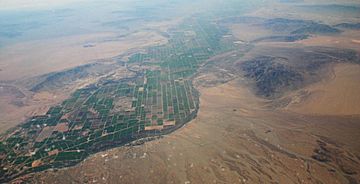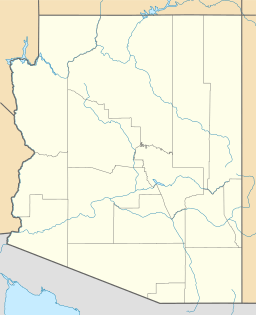Mesquite Mountains (Arizona) facts for kids
The Mesquite Mountains (Arizona) are a small mountain range in western Arizona, in the United States. They are located right next to the Colorado River and the Parker Valley. These mountains are about 13 miles (21 km) long and have a gentle curved shape.
Quick facts for kids Mesquite Mountains (Arizona) |
|
|---|---|

A view looking south from above Parker Valley. The Mesquite Mountains (Arizona) are the small mountains across the Colorado River in Arizona (on the east side).
|
|
| Highest point | |
| Elevation | 1,644 ft (501 m) |
| Prominence | Mesquite Mountain |
| Dimensions | |
| Length | 13 mi (21 km) NE by SW |
| Geography | |
| Country | United States |
| State | Arizona |
| regions | (northwest)-Sonoran Desert Parker Valley & Lower Colorado River Valley |
| County | La Paz County |
| CDP | Poston, Arizona |
| Range coordinates | 33°59′31″N 114°17′02″W / 33.991963°N 114.2838387°W |
Contents
About the Mesquite Mountains
The Mesquite Mountains are not very tall, but they are an important part of the landscape in this desert area. They stretch from the northeast to the southwest. The highest point in the range is called Mesquite Mountain. You can find it in the central-southern part of the range.
Where Are They Located?
These mountains are in La Paz County, Arizona. They sit on the eastern side of the Parker Valley, which is part of the larger Lower Colorado River Valley. This area is also part of the Sonoran Desert, known for its unique plants and animals.
Connected Mountain Ranges
The Mesquite Mountains are actually connected to another mountain range to their south. This other range is called the Dome Rock Mountains. Together, they form a longer chain of hills.
Nearby Waterways
To the east of both the Mesquite Mountains and the Dome Rock Mountains, there is a flat area called the La Posa Plain. A stream bed, or "wash," called Bouse Wash drains this plain. The Bouse Wash eventually flows into the Colorado River Valley, specifically the Parker Valley. It does this by curving around the northern end of the Mesquite Mountains.


